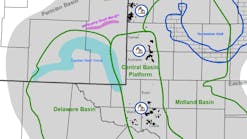Shell plc had first-quarter 2024 adjusted earnings of $7.7 billion, up from $7.3 billion in fourth-quarter 2023, reflecting strong operational performance across the business.
The company commenced a $3.5 billion share buyback program, expected to be completed by its second-quarter 2024 results announcement. Over the last 4 quarters, total shareholder distributions paid were 41% of cash flow from operating activities. Cash capital expenditure outlook for 2024 remains unchanged at $22-25 billion.
In first-quarter 2024, Shell’s adjusted earnings for the upstream division were $1.9 billion, down from $3.1 billion in fourth-quarter 2023, due to increased well write-offs (mainly in Albania). Shell's liquids production for first-quarter 2024 amounted to 1.33 MMboe/d, down from 1.36 MMboe/d in fourth-quarter 2023. Gas production during first-quarter 2024 reached 3.14 MMcfd, up from 2.95 MMcfd in fourth-quarter 2023. Total production for first-quarter 2024 stood at 1.87 MMboe/d, roughly the same as in the previous quarter.
The Integrated Gas division’s adjusted earnings in first-quarter 2024 decreased to $3.7 billion from $4 billion in the prior quarter, due to lower LNG trading and optimization results, partially offset by higher volumes, mainly driven by Prelude FLNG in Australia. Trading and optimization results were strong, but significantly lower compared to an exceptional fourth-quarter 2023.
The Chemicals & Products division reported adjusted earnings of $1.6 billion, up sharply from the previous quarter, thanks to higher refining margins. Higher refining margins in first-quarter 2024 were driven by higher utilization and global supply disruptions. Chemicals losses were also reduced due to improved margin environment and utilization. Meantime, trading and optimization were significantly higher than in fourth-quarter 2023.
Shell’s renewables and energy solutions division reported adjusted earnings of $163 million, in line with adjusted earnings in the prior quarter, as lower trading and optimization margins offset by lower operating expenses. Renewable generation capacity in operation increased as CrossWind, an offshore wind project in the Netherlands, and Madison Fields, a solar project in the USA, reached commercial operation.
